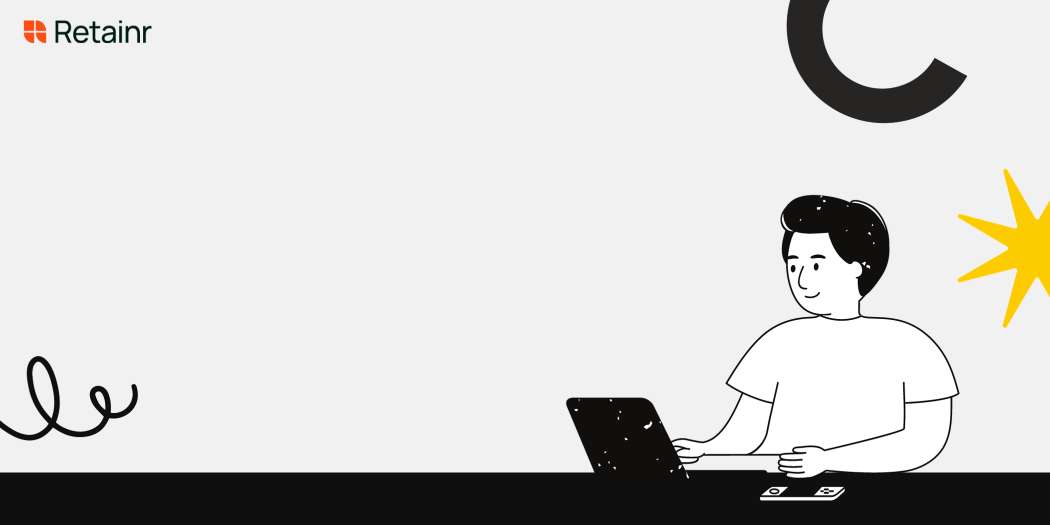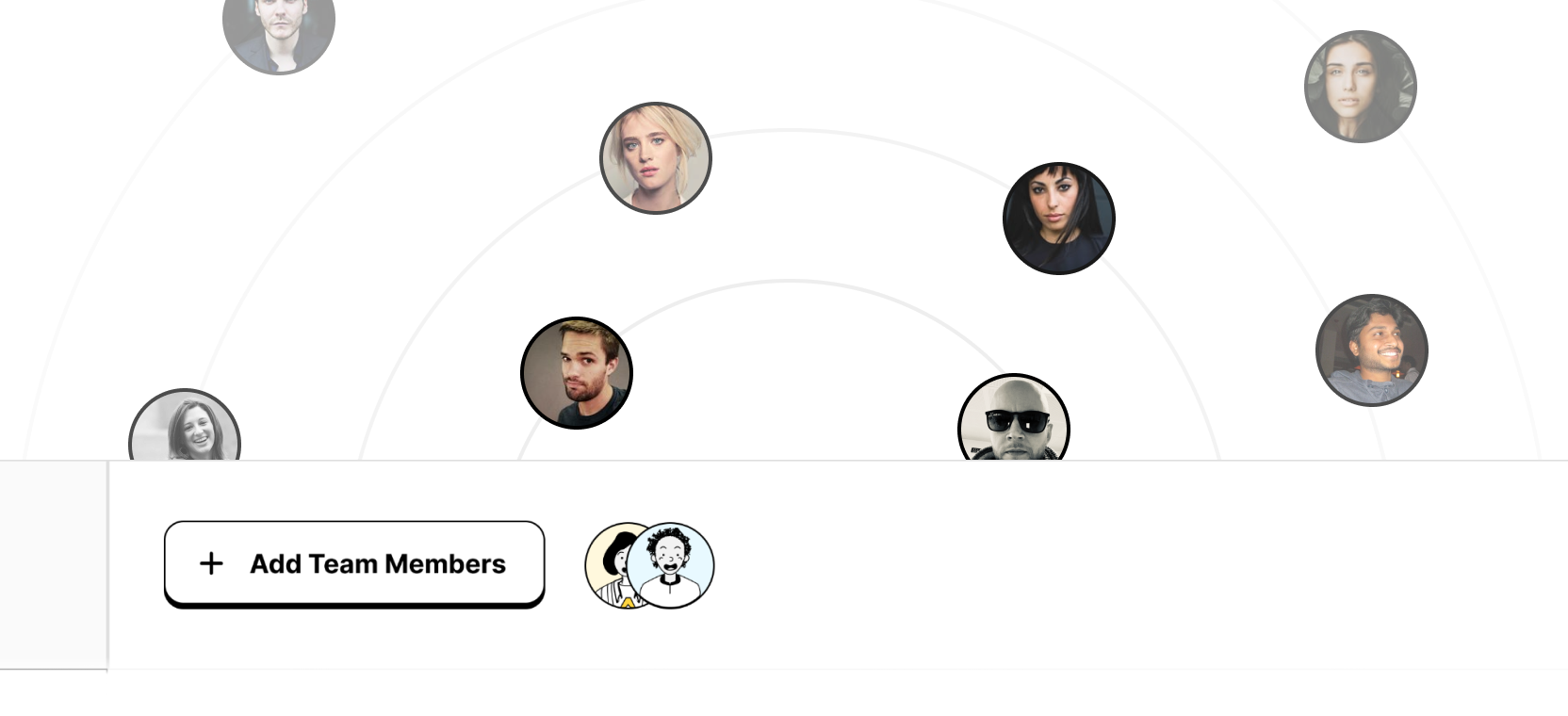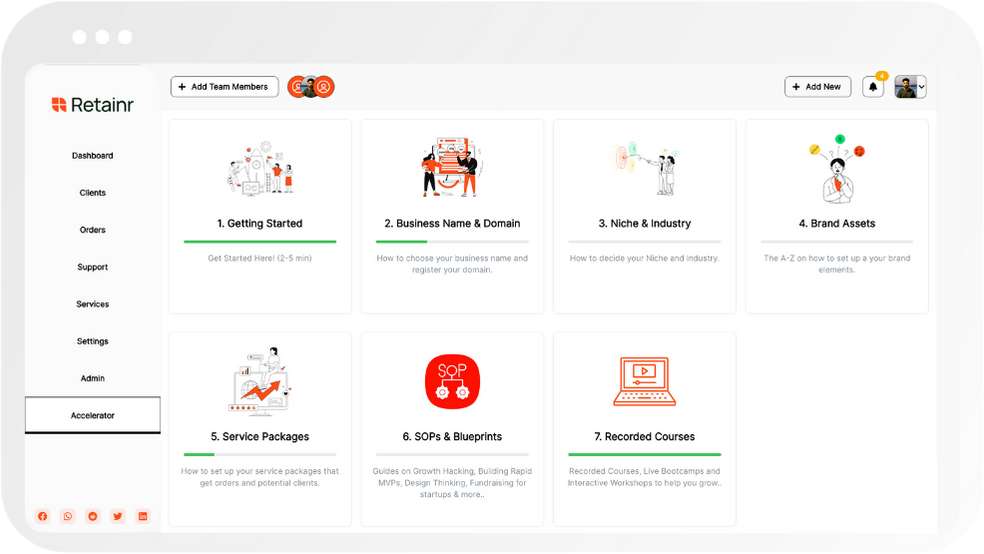
8 Tips and Tactics for Efficient Remote Work Time Management
Build with Retainr
Sell your products and services, manage clients, orders, payments, automate your client onboarding and management with your own branded web application.
Get Started1. What are the top 8 tips for efficient remote work time management?
The Top 8 Tips for Efficient Remote Work Time Management
Managing time effectively is central to achieving productivity while working remotely. Below are eight tips to help you maximize your productivity:
- Create a Dedicated Workspace - This aids focus and helps in separating professional tasks from domestic distractions.
- Prioritize Tasks - Start with the most important and urgent tasks.
- Create a Schedule - This prevents procrastination and allows for breaks.
- Use Time-Management Tools - Utilize digital solutions that can help keep track of time.
- Limit Distractions - This can be achieved by turning off unnecessary notifications.
- Set Boundaries - Establish when you are available for work and when you are not, to avoid burnout.
- Take Regular Breaks - This prevents fatigue and enhances productivity.
- Maintain a Healthy Lifestyle - Regular exercise, good nutrition, and sufficient sleep are crucial.
Efficient Remote Work Time Management Descriptions
| Tip | Description |
|---|---|
| Create a Dedicated Workspace | A designated workspace aids focus and productivity, eliminating distractions. |
| Prioritize Tasks | Concentrate on high-priority tasks first to enhance productivity. |
| Create a Schedule | A strict schedule reduces procrastination and promotes balance and rest. |
| Use Time-Management Tools | Use suitable apps and tools to automate tasks and keep track of time. |
| Limit Distractions | Turn off unneeded alerts and notifications to maintain focus. |
| Set Boundaries | Indicate your available hours to maintain a work-life balance. |
| Take Regular Breaks | Regular breaks help prevent fatigue and keep the mind active and productive. |
| Maintain a Healthy Lifestyle | Sufficient rest, exercise, and nutritious food are critical to maintaining energy and focus. |
2. How can I increase my efficiency and productivity while working remotely?
Set a Consistent Schedule
Working remotely gives you the flexibility of managing your own time, but it can also lead to overworking or underworking. Establishing a consistent work schedule helps provide structure and enables you to manage your time effectively. Ideally, you should align your work hours with your most productive periods. Some tips to increase efficiency include:
- Set start and end times for your workday.
- Take regular breaks. For example, a five-minute break every hour to stretch or a longer lunch break in the middle of the day.
- Separate your work time and personal time. Avoid working outside your scheduled work hours to maintain work-life balance.
Use the Right Tools
Technology and digital tools are integral to remote work. They significantly improve communication, collaboration, and organization, hence increasing productivity. Here are some key tools to consider:
| Tool | Use |
|---|---|
| Project Management Tools | Track project progress, assign tasks, and manage deadlines. |
| Communication Tools | Facilitate real-time communication, foster team collaboration, and instant sharing of ideas and feedback. |
| Time-Tracking Tools | Monitor work hours, breaks, and productivity levels to improve time management strategies. |
Create a Conducive Work Environment
Understanding that not everyone will have an optimal workspace at home, try to make the best out of what you have and make it conducive for work. Having a dedicated workspace free from distractions can greatly enhance your productivity. Below are a few tips:
- Maintain a clean and organized workspace.
- Invest in a comfortable chair, a monitor at eye-level, and proper lighting.
- Ensure a stable internet connection.
- Keep background noise to a minimum.
3. What are some tactics to manage my time effectively in a remote work setting?
Streamline Your Work Process
A top strategy for successful remote work time management involves refining your workflows. Emphasize on clearly defining your tasks and setting realistic deadlines. Here are some useful tips:
- Begin each day with a to-do list. Update it every morning or the night before.
- Break down complex projects into smaller, manageable tasks to avoid being overwhelmed.
- Set deadlines for each task to maintain focus throughout the day.
- Use project management tools like Trello or Asana to systematically organize your work.
Limit Distractions and Stay Focused
In a remote work setting, distractions are not uncommon. It's crucial to create a conducive environment that helps you stay focused on your work. Implement the following strategies:
- Create a quiet and comfortable workspace away from domestic distractions.
- Establish boundaries with others in your space during work hours.
- Invest in noise-cancelling headphones to block out unwanted noise.
- Use technical solutions like site blockers to minimize digital interruptions.
Manage your Breaks Effectively
Manage your breaks with care to maintain the momentum of your work without burning out. Here is a guide:
| Break Type | Duration | Frequency |
|---|---|---|
| Morning Break | 10 minutes | Once in the morning |
| Lunch Break | 30-60 minutes | Once per day |
| Afternoon Break | 10 minutes | Once in the afternoon |
4. How can I reduce distractions while working remotely for efficient time management?
Identify and Minimize Distractions
One of the main challenges of remote work is the abundance of potential distractions. These can range from environmental distractions such as noise or people, to digital distractions such as social media. To minimize these, first identify your main sources of distraction. It may be helpful to keep a distraction log for a few days to accurately pinpoint what takes away your focus from work.
- Environmental Distractions: Create a dedicated work area that's free of clutter and noise. Let family members or housemates know your work schedule to avoid being interrupted.
- Digital Distractions: Turn off unnecessary notifications on your phone and computer. Use apps or browser extensions that block access to distracting websites or apps during work hours.
- Personal Distractions: Plan regular breaks to avoid burnout. This can be in form of a short walk, a quick snack, or a few minutes of meditation. It is also important to stay physically active and maintain a healthy diet to improve focus and productivity.
Use Time Management Tools
Several tools can help improve focus and productivity when working remotely. Time management apps, for instance, can help structure your workday by setting specific times for different tasks. They can also monitor your activity to ensure you stay on track.
| Tool | Function |
|---|---|
| Pomodoro Technique | This method breaks your workday into 25-minute work periods followed by 5-minute breaks. |
| RescueTime | This app tracks the time you spend on different activities and provides detailed insights into your productivity. |
| Focus@Will | This tool offers a variety of music and sounds designed to improve focus and productivity. |
Stay Organized
Finally, staying organized is key to efficient time management when working remotely. This pertains not just to your workspace, but also your tasks and schedule. Use tools and strategies that help streamline your workflow, making it easier to keep track of tasks and deadlines.
- Keep your workspace tidy: Clutter can be distracting and can reduce productivity. Make sure your workspace is clean and that everything you need is within arm's reach.
- Use project management tools: Tools like Asana, Trello, and Monday help keep tasks and deadlines organized.
- Plan your day: At the start of each day, take a few minutes to plan out your tasks and priorities. This can be done using a physical planner or digital tools like Google Calendar.
5. What role does communication play in effective remote work time management?
The Importance of Communication in Remote Work Time Management
Communication has a crucial role in every workplace, and it has never been more important than while working remotely. Not only does efficient communication establish clarity and avoid misunderstandings, but it also enhances organization, productivity, and effective time management. Here are three main reasons how regular communication can aid in time management:
- Clarifies Tasks: The sharing of clear instructions and expectations eliminates confusion and ensures that tasks are accurately performed, preventing time waste.
- Improves Coordination: With effective communication, collaboration increases, enhancing coordination and reducing idle time spent waiting for co-workers' responses or updates.
- Boosts Morale: Regular communication, especially feedback and recognition, increases employee motivation and productivity, leading to more efficient use of work time.
Effective Communication Strategies for Time Management
To harness the full benefits of effective communication for time management, it is essential to adopt certain strategies. Here are three key strategies that can significantly impact your remote work time management:
- Use the Right Tools: Depending on the nature of the communication, select tools that best suit your needs, such as email for formal communication, instant messaging for quick updates, and video conferencing for team meetings.
- Establish Clear Communication Guidelines: This includes defining the communication channels, the 'response time' expectations, and the type of information to share through different platforms.
- Schedule Regular Check-ins: Routine communication, either individually or with the team, could provide the space for feedback, updates and planning, giving you better control over your time.
Comparative Analysis of Communication Tools for Remote Work
| Communication Tool | Best For | Advantages |
|---|---|---|
| Formal communication | Provides a record of communication, good for sharing detailed information | |
| Instant messaging | Quick updates, informal chats | Real-time exchange of information, reduces response time |
| Video Conferencing | Team meetings, presentations | Fosters a sense of community, enables visual and verbal communication |
6. Can you suggest some tools for effective time management while working from home?
Time Management Tools
Utilizing proper time management tools plays an integral role in your overall productivity when working from home. Focusing on tasks at hand can be challenging without having a few aids to help keep you on track. Below are some of the highly effective tools for remote work time management:
- Asana: This project management tool aids in organizing tasks, setting priorities, and sharing details with your team members.
- Trello: A user-friendly tool that uses cards to represent tasks and columns to represent stages of progress.
- Zapier: Used for automating routine tasks thereby saving time.
- Google Keep: Excellent for quick-notes and to-do lists, this is especially beneficial for brainstorming sessions and gathering thoughts.
- RescueTime: Gives you a detailed report of how you spend your time, helping you to work more efficiently.
- Focus@Will: Provides a series of ambient music designed to boost your focus and productivity.
Comparative Analysis of Time Management Tools
Every tool has its unique features that make it suitable for particular tasks. A comparative analysis of some common tools is given in the table below:
| Tool | Features | Best Used for |
|---|---|---|
| Asana | User-friendly interface, built-in calendar, advanced search, reporting tools | Project management and collaboration |
| Trello | Easy organization with tags and labels, automation, data filters, summarizing tool | Workflow organization and management |
| Google Keep | Color-coded notes, image addition, reminders, sharing options | Simple note taking, reminders and to-do lists |
7. How important is it to create a dedicated workspace for efficient remote work time management?
Importance of a Dedicated Workspace for Efficient Remote Work Time Management
A dedicated workspace is highly essential for enhancing efficiency in remote work time management. It can help you stay organized, minimize distractions, and maintain work-life boundaries. Whether its a fully-equipped office room, a small desk in a corner, or a portable workstation, the goal is to have a space that associate with work.
Reasons to Earmark a Specific Workspace
- Mental Space: A dedicated workspace prepares your mind for work. It is a physical indicator that it is time to switch to a work mindset.
- Improved Productivity: It helps limit distractions that can interfere with your productivity. With designated spaces for work activities, interruptions can be minimized.
- Work-Life Balance: It aids in maintaining work-life balance. When you leave your workstation, it should also feel like you are leaving work behind.
- Organization: It promotes organization, as you have space for all your work essentials. This saves you the time spent searching for things.
| Workspace | Pros | Cons |
|---|---|---|
| Full home office room | Plenty of space, more privacy, minimal distractions | Needs more space, higher cost |
| Small desk in a corner | Compact, easy to setup, affordable | Not enough space, can get crowded |
| Portable workstation | Flexible, can work from anywhere, easy to organize | Depends on available space, may not be comfortable |
Choosing the right workspace can depend on various factors like space limitations, budget, and personal working preferences. Regardless, having that dedicated workspace can make it easier to organize your work, stay focused, manage your time better, and ultimately be more productive while working remotely.
8. How can setting boundaries improve my time management when working remotely?
Importance of Setting Boundaries
Working remotely comes with a blurred line between personal and professional life. It's easy to lose track of time and work long hours without realising it. This is where setting boundaries come into play. Boundaries not only ensure a healthier work-life balance but significantly improve your time management skills. Here are three notable reasons:
- Work-Life Balance: With a boundary in place, you ensure you're not overworking. It forces you to switch off from work and engage in personal activities, consequently preventing burnout.
- Better Productivity: Strikingly, research shows resting and detaching from work boosts your productivity levels. You're more likely to perform better when you know you're working within a set time frame.
- Proper Planning: When you're aware of your availability, you can plan your tasks more effectively. You can allocate time slots to different projects and ensure timely completion.
Tactics for Setting Boundaries
Setting boundaries requires a level of discipline and strict adherence. Here are four practical tactics that can assist in setting well-defined boundaries:
- Set a Schedule: Stick to a regular work schedule. Determine start and end times for your workday.
- Create a Workspace: Allocate a specific area in your home for work. This physical segregation will foster mental separation between work and personal life.
- Take Regular Breaks: Ensure you're taking hourly breaks to stretch, hydrate or just rest your eyes.
- Use Technology: Make use of project management tools and apps that can help track productivity and promote efficient time management.
Time Management Improvement After Setting Boundaries
The table below shows the potential improvement in time management once boundaries are effectively set:
| Before Setting Boundaries | After Setting Boundaries |
|---|---|
| Long, undefined work hours | Defined work schedule |
| Poor planning and scheduling | Improved task planning |
| Higher chances of burnout | Lower risk of burnout |
| Low productivity levels | Improved productivity |
9. What is the significance of regular breaks for efficient remote work time management?
The Importance of Regular Breaks
When working remotely, taking regular breaks has profound significance for efficient time management. Unlike a traditional office environment, remote work rarely offers built-in breaks, leading you to continuously work without breaks, often resulting in decreased productivity and focus. To explain the importance, regular breaks can be broken down into three key areas:
- Mental Recharge
- Physical Comfort
- Maintaining Work-Life Balance
Benefits of Breaks in Remote Work
| Benefit | Detail |
|---|---|
| Mental Recharge | Taking breaks allows your mind to rest and replenish, improving your concentration and productivity when you return to work. |
| Physical Comfort | Just few minutes of movement during your breaks can help to avoid health issues caused by long sedentary hours. |
| Maintaining Work-Life Balance | Breaks can serve as a reminder to engage in other non-working activities, helping you maintain a healthy work-life balance. |
Implementation of Regular Breaks
To implement regular breaks effectively and ensure smooth workflow, follow these three tips:
- Time your work sessions and plan short breaks, typically 5-10 minutes for every hour of work.
- Use the breaks to physically move around, whether that's a short walk or some simple stretches.
- Disconnect completely during your breaks. Avoid looking at your work screen or thinking about work tasks.
Adopting a diligent break routine can make you more effective at managing your remote work time, leading to higher productivity and job satisfaction.
10. How can creating a daily routine help in managing time effectively during remote work?
The Importance of Creating a Daily Routine
Establishing a daily routine can greatly help in managing time effectively during remote work. It acts like an organizer, enabling you to accomplish tasks efficiently. With a well-structured routine, you're able to optimize your productivity and develop habits that bring structure to your daily activities. Here are the ways a daily routine aids in time management:
- Organization: Having a routine helps organize your tasks in order of priority, ensuring each task is allotted a specific time slot.
- Increased productivity: A routine keeps you focused on tasks that need to be done, eliminating time wastage and improving productivity.
- Reduced stress: Routines eliminate the uncertainty of not knowing what to do next, reducing work-related stress.
Creating a Routine for Efficient Time Management
Developing a routine aids in organizing and structuring the workday to get the most done. Here are steps on how to create an effective routine:
- List down all the tasks that make up your workday.
- Categorize these tasks based on priority and deadlines.
- Allocate specific time slots for each task based on their complexity and urgency.
- Consistently follow the established routine and modify it as necessary to fit changes in work demands.
Time Allocation for Common Tasks
Here's an example of how time can be allocated for a typical remote workday:
| Task | Time Allotted |
|---|---|
| Checking and replying to emails | 8:00 - 9:00 AM |
| Working on high-priority tasks | 9:00 AM - 12:00 PM |
| Lunch and rest | 12:00 - 1:00 PM |
| Attending meetings | 1:00 - 3:00 PM |
| Working on secondary tasks | 3:00 - 5:00 PM |
| End-of-day wrap-up and planning for next day | 5:00 - 6:00 PM |
Conclusion
Master Remote Work Time Management with these 8 Tips
Effective time management is vital when working remotely. Here are some handy tactics to ensure you're staying productive and efficient when in a remote setting:
- Stick to a Routine: Maintain consistency by following the same daily routine, as you would do in a traditional office.
- Structure Your Day: Allocate blocks of time to specific tasks, setting clear working times and break periods.
- Stay Organized: Use digital planning tools to keep all of your tasks, due dates, and deadlines in order.
- Minimize Distractions: Create a distraction-free workspace that allows you to focus on the task at hand.
- Prioritize Your Tasks: Rank your tasks based on their importance or urgency to ensure that critical work is completed first.
- Take Regular Breaks: Regular short breaks can keep your mind fresh and your productivity levels high.
- Manage Your Communication: Regular updates with team members maintain work flow and identification of potential issues early.
- Use Appropriate Tools: There are numerous digital tools available for remote work that provide convenient features for task management, communication, file sharing.
Boost Your Efficiency with Retainr.io
Incorporating tools like Retainr.io is also crucial to managing time effectively while working remotely. Retainr.io is a whitelabel software that allows you to sell, manage clients, orders, and payments with your own branded app. It ensures smooth operations, from order processing to payment, all in a user-friendly interface. Whether you're a solopreneur or managing a team, Retainr.io can help streamline your operations, enhance productivity and, ultimately, save precious time. Why not check it out today?
Boost Your Agency Growth
with Retainr Accelerator
Uncover secrets, strategies, and exclusive blueprints to take your agency's growth to the next level — from marketing insights to effective presentations and leveraging technology.

SOPs, Cheatsheets & Blueprints
Leverage 50+ SOPs (valued over $10K) offering practical guides, scripts, tools, hacks, templates, and cheat sheets to fast-track your startup's growth.
Connect with fellow entrepreneurs, share experiences, and get expert insights within our exclusive Facebook community.
.jpg)

Join a thriving community of growth hackers. Network, collaborate, and learn from like-minded entrepreneurs on a lifelong journey to success.

Gain expertise with recorded Courses, Live Bootcamps and interactive Workshops on topics like growth hacking, copywriting, no-code funnel building, performance marketing and more, taught by seasoned coaches & industry experts.

.jpg)

.jpeg)


